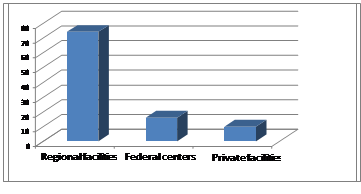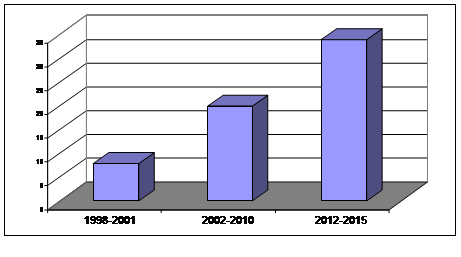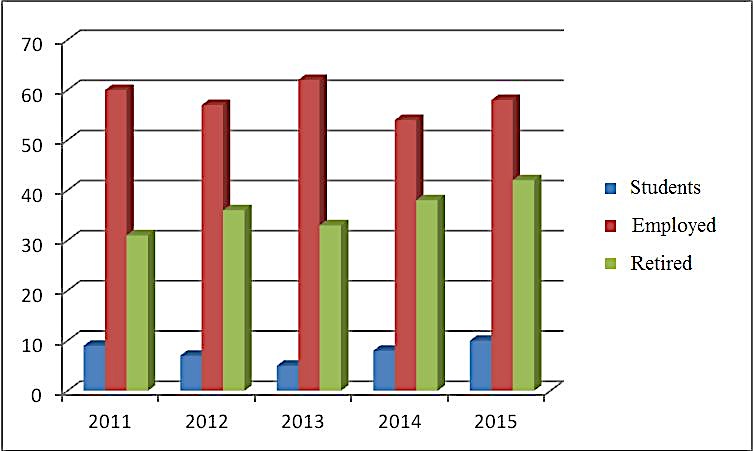Abstract
This article reviews the issues of social obligations of the private sector as the responsibility of the company for its activities towards the society and the state. The corporate social responsibility is clearly structured and carried out at multiple levels such as compliance with laws, maintenance activities which are attractive for investors and consumers, implementation of measures aimed at removing social tensions. It is shown that the changes in the public sector of the healthcare toward increase in the share of for-profit health care centers improves social climate by increasing accessibility and quality of the medical care. This article demonstrates the place, role and forms of the participation of the non-state multifaceted medical centers in the implementation of socially oriented projects. The authors offer to use the concept of social responsibility of the private sector as an instrument for achieving and securing the sustainable growth of both the business and the society as a whole
Keywords: Healthcare systemnon-state healthcare organizationssocial responsibility of the private sectorsocially important projectshuman welfare
Introduction
National health has without any doubt a great social value, it is a priority of the state policy, a basis for the national wealth and security, it reflects the viability and geopolitical perspectives of the nation (Obama, 2010; Strong, 2010; Koh, et al., 2013, U.S. Department of Health and Human Services, 2010, Weiss, 2007). At the same time, “health” is a sphere of the mutual interests and mutual responsibility of the state, society and a person. Healthcare system in Russia is a subject of a strict hierarchy, but simultaneously it is dynamic. Structure of the healthcare in Tomsk region (TR) in the administering of the ambulatory care for the population is based on the federal, regional institutions as well as on the multifaceted non-state healthcare organizations According to the data from the Department of Healthcare of Tomsk region (on 2015) non-state healthcare organizations constitute only a small percentage of the total volume of the healthcare organizations (fig.

Currently the modernization of the public sector of the healthcare system is still underway in the Russian Federation. Systematic actions of the Russian Government are aimed at that: (1) making amendments to the Fundamental principles of the legislation concerning healthcare of citizens, systematizing main concepts; (2) adoption of the Federal law 326 “About mandatory health insurance” of 29.11.2010, expanding the rights of the private medical organizations on the participation in the programs of the mandatory health insurance; (3) adoption of the draft order of the Ministry of Health and Social Development of the Russian Federation “About confirmation of the rules of the mandatory health insurance”, forming single rules on the provision of the medical care and consistent approaches toward tariff setting.
State is interested in the improvement of the quality of the provided health care; for the private sector it could be a profitable investment, which can simultaneously perform socially important tasks. In which case a number of general conditions is being observed, under which we understand political stability, determining the continuity of the sociopolitical course and permanence of the interaction standards, as well as provision of the balanced risks, which should be adequately distributed among the participants of the system.
Tomsk region is an innovative territory and a platform for the implementation of the pilot projects of the Government of the Russian Federation in the sphere of healthcare. The result of the implementation of the healthcare modernization projects in 2005-2009 is the introduction of the single-source financing, a “full” tariff for the mandatory health insurance and partial asset holding (Program of healthcare modernization in Tomsk region for 2011-2012). Private healthcare on the territory of Tomsk takes part in the provision of the Program on State Guaranties since 1998. For the period from 1998 to 2001 three non-state healthcare organizations participated in it, in 2002-2010 there were eight such organizations, and by 2015 their number has reached seventeen (fig.

The refore, private medical sector actively takes its niche in the system of Russian healthcare, providing a significant amount of medical services in the framework of partial asset holding, forming the prerequisites for the organization of the public-private partnership (Dobrusina et al, 2011, Rasskazova, & Rozhkova, 2014, http://zdrav.tomsk.ru/Nac_proekt/programma_11-12/index.html, 2011-2012).
Another one important direction in the work of the non-state healthcare organizations is the implementation of the socially important medical projects for the population with the aim of increasing accessibility and quality of the medical help. In this case the participant of the project, private healthcare, takes upon itself handling of all problems and burden of the risks: commercial, managerial, and marketing. A strategy of a private medical organization’s behavior on the healthcare services market depends largely on the understanding that a substantial increase in the quality of life and improvement of the social well-being of the citizens is impossible without involvement of the civil society structures in this process. Participation of a multifaceted non-state healthcare organization in social projects assumes a social responsibility of such organization.
Social responsibility of the private sector is a complex of obligations that correspond with the specifics and the level of company’s development, is being regularly reviewed and changes dynamically. Such obligations are developed voluntary and in a coherent manner with participation of the key concerned parties. They are adopted by the company management with due regard to the opinions of the personal and shareholders and implemented principally at the expense of the company’s means. Their aim is to implement important internal and external social programs, results of which contribute to the development of the company, improvement of its reputation and image, formation of the corporate identity, development of the corporate brands, and also widening of the constructive partnership ties with the state, business partners, local communities, and civil society. The broadest interpretation of the concept of the social responsibility of the private sector includes: (1) corporate social policy towards society; (2) corporate management and corporate integrity; (3) healthcare and on-the-job safety; (4) policy in the sphere of environmental protection; (5) human rights; (6) human resource management; (7) interaction with the society, development and investment; (8) corporate charity and volunteering; (9) satisfaction of the customer’s requirements and adherence to the principle of fair competition; (10) bribery control and anti-corruption measures; (11) accountability, transparence and provision of information about activities; (12) human right issues in the relations with the suppliers in the national and in the international chain of contractors and suppliers (Alekseeva, 2004; Kurinko, 2014). Essentially, social responsibility of the private sector is a concept according to which companies voluntary decide to contribute to the improvement of the society and the environment (Krylov, 2013, Anderson, 1989, Carroll, 2010, Walton, 1967, Miller, 1993). This definition and the conception can be to the full extent applied to the activities of the non-state healthcare organization. Social responsibility of the private sector can be viewed upon from different perspectives: state, societal, business. In view of the aforesaid it appears interesting to evaluate the social component of the social responsibility of the private sector on the example of the activities of the multifaceted non-state healthcare organization.
Research methods
The object of the research was the private medical center Limited liability company “Diagnostic and treatment center” (“LDC”, LLC), operating on the market of the paid medical services in Tomsk. As a material for the research we used the “mammology campaign” that is being conducted by “LDC”, LLC annually during last five years. Duration of the campaign was two months. The population was informed about the campaign via mass media. Appointments with breast physicians were made via specially created call-center. By appointment women were informed about the date, time and the conditions of the examination. In order to achieve bigger coverage of the target audience, the number of breast physicians, ultrasonic medical investigation specialists and morphology specialists. Examinations were conducted using ultrasonographs (LOGIQ P3 GE, LOGIQ P6 GE) and mammography unit (ALPHA ST). During the research we evaluated the age, social status, occupation, place of residence, presence of the patient’s complaints on the part of the mammary gland, ability to conduct a self-examination, participation in the clinical examination, awareness of the necessity of the regular examination. A survey was conducted aimed at the evaluation of the medical service during the “mammology campaign”. Results of the examinations were processed using mathematical statistics methods and were entered into the "LDC", LLC database.
Findings
Analysis of the results showed that the total number of the patients who came to the appointment with the breast physician was 5317 people for the whole period of study. Distribution of patients over age, social status and place of residence is shown in table
In general, the percentage distribution of the patients across age groups was even. The most active group turned out to be women in the age group 30-65 years. Lower activity was visible in the group of young women (25-30 years). Age category 65-80 years was characterized by the lowest amount of appointments (table
Evaluation of the social status has shown that almost 30% from the total amount of women who have taken part in the “mammology campaign” were retired, 9% - students, and 61% - employed. This data points to the high social activity of the categories “retired” and “employed” (table

This “social drift” could probably be explained by the increasing popularity of the “mammology campaign” and natural transition of women from one age group to another.
In the structure of the visits to the breast physician, residents of Tomsk were on the first place, while women living in the region took the second place, which is connected with the higher accessibility of the medical care in the city compared to the region.
It is notable that about 30% of the women didn’t have knowledge about breast cancer and about 25% of all patients didn’t have any self-examination skills.
Examining the complaints on the part of the mammary gland the following was revealed: number of appointments with total absence of complaints - 75%. with complaints - 25% (from which on galactorhea - 3%, plugged duct - 10%, mastalgia - 4%, mastodynia - 7%, and mastitis - 1%).
Patients without complaints and in the age group 50-69 years theoretically composed a group for breast cancer screening.
It should be mentioned that there are several priority health care directions in Russia. One of them if a state program on the breast cancer screening. Screening is a mass test examination of the healthy population segment in order to reveal illnesses on the early stages, which leads to the reduction of mortality. According to the WHO for the quality mammography screening following is necessary: 1) presence of the modern diagnostic equipment stock: mammography unit, ultrasonographs, complexes for stereotaxic biopsy; 2) active participation of the female population in the screening; 3) participation in the screening of only healthy females, having no complaints about swelling in a mammary gland; 4) age of the examined - 50-69 years; 5) availability of the cancer-register for the precise accountance of the morbidity and mortality indices (Rasskazova, & Rozhkova, 2014, Green, & Taplin, 2003, Smith et al., 2004, Duffy, 2005, Lim et al., 2010, Sinclair et al., 2011). Multifaceted non-state healthcare organizations could meet the above mentioned conditions.
Evaluating the group of patients as a population segment subject to the breast cancer screening, the following results were obtained (table
The research revealed that the third of the group constituted of the almost healthy women, in others some pathology was found, including breast cancer (0.3%) (table
It is worth noting that more than half of the patients, who came to the appointment with breast physician in the first year of the campaign, came to the "LDC", LLC during the next “mammology campaigns” as well.
A question arises: “What was the reason for the women from Tomsk and the region to be so active in visiting the breast physician at the multifaceted private medical center, when there are specialized oncologic medical center and dispensary in Tomsk?” Most probably there are several explanations possible: (1) this type of the medical help is insufficient for the city and the region, specialized institutions are concerned with already ill people, and screening of the healthy citizens is not carried out actively enough; (2) high level of trust from of the population for the quality of the medical services provided by multifaceted non-state healthcare organizations; (3) absence of the awareness campaigns on the topic of breast cancer.
Survey conducted among patients showed a great interest of the population in medical campaigns. Respondents noticed positively: (1) free provision of the qualified medical help; (2) high level of awareness about “mammology campaign”; (3) possibility to visit specialist on the weekend; (4) repeat reminder about the appointment; (5) timing of the appointment; (6) high level of the consultations given by the breast physicians; (7) trainings in self-examination, (8) coordinated work of the medical managers. The requests could be boiled down to the necessity to make campaigns regular, increase their duration, and provide information materials on the topic of the examination.
Conclusion
Our research revealed the relevance of the free medical examination conducted by the multifaceted non-state healthcare organization, which increases the accessibility for particular types of medical care. The fact that private medical centers are equipped with technical and personnel resources allows them to carry out medical and preventive events, which are in demand among vulnerable segments of the population. Therefore, it was shown that the adoption of the social responsibility of the private sector concept by companies is mutually important for society and for private sector itself.
Acknowledgement
This research was carried out with the support of the "LDC", LLC.
References
- A. Strong (2010). Britain in an Age of Uncertainty: National Security Strategy. Retrieved from https://www.gov.uk/government/uploads/system/uploads/attachment_data/file/61936/national-security-strategy.pdf
- Alekseeva, O. (2004). Social responsibility of the companies - Western and Russian experience. Internet journal “Metsenat”. Retrieved from http://www.maecenas.ru/doc/2004_3_5.htm (in Russian)
- Anderson, J. (1989). Corporate Social Responsibility. N.Y.: Quorum Books.
- Cancer Screening Program, 2004-2008. Cancer Res.Treat, 42(4), 199-202.
- Carroll, A.В. (2010). The business case for corporate social responsibility: a review of concepts, research and practice. International Journal of Management Reviews, 12(1), 85-105.
- Dobrusina, M.E., Zavyalova, G.N., Tulupoa, O.N., & Khlinin, S.M. (2011). Public-private partnership as an innovative form of the Russian healthcare development. Tomsk State University Journal of Ecomomics, 1(13), 142-147. (in Russian)
- Duffy, S.W. (2005). Some current issues in breast cancer screening. J. Med. Screen, 12, 128-133.
- Green, B.B., & Taplin, S.H. (2003). Breast Cancer Screening Controversies. J. Am. Board Fam. Pract., 16, 233–241.
- Kazakovtseva, M.V. (2004). Teoretical aproaches to the defenition of the notion of public-private partnership. Modern problems of science and education, 3. Retrieved from http://www.science-education.ru/ru/article/view?id=13495 (in Russian)
- Kholopov, A.V. (2014). Report. Retrieved from http://zdrav.tomsk.ru/ru/departament/itogi-raboty-departamenta/itogi
- Kholopov, A.V. (2015). Report. Retrieved from http://zdrav.tomsk.ru/ru/departament/itogi-raboty-departamenta/itogi
- Koh, HK, Brach C, Harris LM, & Parchman M. (2013). A proposed health literate care model would constitute a systems approach to improving patients’ engagement in care. Health Aff, 32(2), 356-357.
- Krylov (Hg.) A. (2013). Corporate Social Responsibility: Wirtschaftsmodelle – Moral – Erfolg – Nachhaltigkeit. Verlag Ikar Moskau. Berlin: West-Ost-Verlag.
- Kurinko, R.N. (2014) What is a social responsibility of the private sector. Sustainable Business. Retrieved on 12/05/2014 from: http://csrjournal.com/839-chto-takoe-sob-chto-takoe-socialnaja.html (in Russian)
- Lim, S.M., Lee, H.-Y., Choi, K.S., Jun, J.K. & et al. (2010). Trends of Mammography Use in a National Breast.
- Miller, F.D. (1993). The social responsibility of corporations. NJ: Business Ethics: A Philosophical Reader, Prentice-Hall.
- Obama В. (2010). National security strategy. Retrieved from http://www.whitehouse.gov/sites/default/files/rss_viewer/national_security_strategy.pdf
- Program of healthcare modernization in Tomsk region for 2011-2012. Retrieved from http://zdrav.tomsk.ru/Nac_proekt/programma_11-12/index.html
- Rasskazova, E.A. & Rozhkova, N.I. (2014). Screening for the early diagnostics of the breast cancer. Research and Practical medicine Journal, 1( 1), 45-51. (in Russian)У Ч Н О –
- Sinclair N., Littenberg B., Geller B & Muss H. (2011). Accuracy of screening mammography in older women. AJR Am. J. Roentgenol., 197(5), 1268-1273.
- Smith, R.A., Duffy, S.W. & Gabe, R. (2004). The randomised trials of breast cancer screening what have we learned. Radiol. Clin. N. Am., 42, 793-806.
- U.S. Department of Health and Human Services (2010). Washington, DC,
- Walton, C.C. (1967). Corporate social responsibilities. Belmont, CA: Wads worth.
- Weiss B. (2007). Health Literacy: A Manual for Clinicians. JAMA, 306 (10), 1122-1129.
Copyright information

This work is licensed under a Creative Commons Attribution-NonCommercial-NoDerivatives 4.0 International License.
About this article
Publication Date
17 January 2017
Article Doi
eBook ISBN
978-1-80296-018-1
Publisher
Future Academy
Volume
19
Print ISBN (optional)
-
Edition Number
1st Edition
Pages
1-776
Subjects
Social welfare, social services, personal health, public health
Cite this article as:
Pozdnyakova (Nadezhda Provalova), ., Kashkan, G., & Churin, A. (2017). Social Responsibility of the Private Sector in the system of Russian Healthcare. In F. Casati, G. А. Barysheva, & W. Krieger (Eds.), Lifelong Wellbeing in the World - WELLSO 2016, vol 19. European Proceedings of Social and Behavioural Sciences (pp. 283-290). Future Academy. https://doi.org/10.15405/epsbs.2017.01.39

